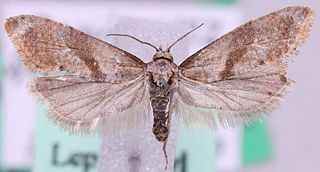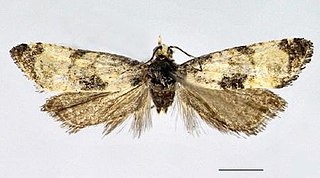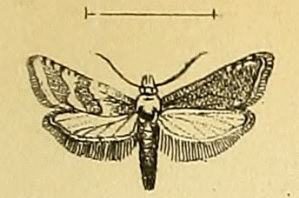
The Cochylini are a tribe of tortrix moths. It used to be classified as the subfamily Cochylinae.

Cochylis is a genus of moths belonging to the subfamily Tortricinae of the family Tortricidae.

Falseuncaria is a genus of moths belonging to the family Tortricidae.

Cochylis hybridella is a moth species of the family Tortricidae. It is found in most of Europe, the Near East, China, Japan, Korea and Russia.

Cochylichroa atricapitana, the black-headed conch, is a moth of the family Tortricidae. It is found in China (Xinjiang) and the eastern Palearctic and most of Europe.

Cochylis discerta is a moth of the family Tortricidae. It is found in China and Mongolia.

Cochylis dubitana, the little conch, is a moth of the family Tortricidae. It is found in China (Heilongjiang) and most of Europe. and the Caucasus. It is also found in North America, where it has been recorded from Colorado, Maine, Ontario and Washington.

Cochylis faustana is a moth of the family Tortricidae. It is found in China and Russia.

Cochylis posterana is a moth of the family Tortricidae. It is found in Europe, Iran and China.

Cochylis triangula is a moth of the family Tortricidae. It is found in China in Guizhou and Yunnan.

Cochylis defessana is a species of moth of the family Tortricidae. It is found in Bulgaria, Romania, Greece, China (Xinjiang), Iran and Turkey.
Cochylis piana is a species of moth of the family Tortricidae. It is found in Mongolia, China, Kazakhstan, Tajikistan, Uzbekistan, Kyrgyzstan, Afghanistan, Iran and Russia.
Cochylis psychrasema is a species of moth of the family Tortricidae. It is found in China.
Cochylis campuloclinium is a species of moth of the family Tortricidae. It is found in Argentina.
Falseuncaria aberdarensis is a species of moth of the family Tortricidae. It is found in Kenya.
Falseuncaria brunnescens is a species of moth of the family Tortricidae. It is found in Shanxi, China.

Falseuncaria ruficiliana, the red-fringed conch, is a species of moth of the family Tortricidae. It is found in China (Xinjiang) and most of Europe. The habitat consists of limestone, heathland and moorland.
Falseuncaria kaszabi is a species of moth of the family Tortricidae. It is found in China and Mongolia.
Falseuncaria lechriotoma is a species of moth of the family Tortricidae. It is found in China (Hebei) and Mongolia.
Falseuncaria rjaboviana is a species of moth of the family Tortricidae. It is found in the country of Georgia.












